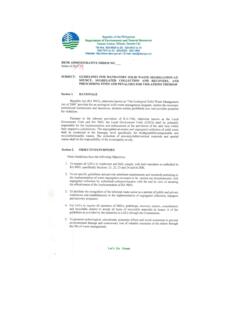Transcription of CASE MANAGEMENT RULES - CBHC
1 CASE MANAGEMENTA ssessmentDeveloping a Care PlanReferral to ServicesMonitoring & Follow-upCCQC: Is it possible to do this alone? Training programs can get to be very expensive especially when all of the costs actual and opportunity costs are included Resource limitations force too many providers to use ineffective on the job training programs which can range from inconsistent to very scary Standardized training tools are critical but they must be updated to keep interest and freshness of the material trainers get bored too.
2 Behavioral Health Risk Centers around two primary issues1) are we providing covered services that are medically necessary2) are we documenting these services so that an auditor realizes thisBrief Background Case MANAGEMENT considered high risk by OIG and CMS Costs high, value uncertain Mostly abuse by states Resulted in a change to the definition of case MANAGEMENT by Congress in the Deficit Reduction Act Brief Background Remaining advice is a State Medicaid Director s letter, the DRA definition, and the post-moratorium CMS all in your handouts Colorado intends to submit a SPA for TCM right now providers operating under current definition which is clinic based HCPF has informed CMS that providers are currently doing community based CMMedical Necessity The payers perspective1) Definition is controlled by the payer2) Multi-dimensional decision-making but big question is, is it necessary?
3 3) CM or not? 4) Cost-effectivenessDocumentation Without complete clinical record documentation, including a description of what took place in a therapy session, the medication prescribed, the individual s interaction with group members, his or her progress compared to the treatment plan goals, and future plans of treatment, the appropriateness of the individual s level of care is unclear. Documentation Furthermore, inadequate documentation of individual therapies and treatment provides little guidance to physicians and therapists to direct future treatment.
4 In this regard, the lack of required documentation precludes reviewers from determining whether those services are needed. Case MANAGEMENT Remembering always : Documentation is not a means of gaming the system; of just making sure you are using the right words Documentation is an accurate depiction of a covered service that actually took place with some analysis of the intervention s impact on the progress of the individual towards their own goals. This training is designed to spend the bulk of the time helping trainees figure out what Case Managers are supposed to do.
5 Not just how to document Real Basic RULES Medicaid and MedicareMedicaid Primary payer of community-based mental health services, including case MANAGEMENT Joint payment by both the federal government and the state -so they both have a say as to how services are provided Highly regulated industry CURRENT ENVIRONMENT: Enforcement and Oversight The government understands that it needs to bend the cost curve in health care and so it looks for savings in efficiencies, implementation of better models AND the reduction of fraud, abuse and waste in the system.
6 Colorado CMHCs Get Paid We get a set amount each month for each Individual assigned to us as a member to provide all of their mental health needs. The amount we get paid in this set amount is dependent on the health care status of the individual. We track the services we provide by submitting encounters to the Behavioral Health Organizations which are responsible for managing the Medicaid mental health dollars for the state. For the purposes of compliance encounters and claims are the same thing. Everything that is therapeutic is not billable Remember Medicaid is like any other insurance it only pays for covered services Therefore understanding the definition of case MANAGEMENT services is critical 14 With Medicaid: Rule #1 To become a Medicaid provider you must meet certain criteria: We must be a licensed CMHC to be a Medicaid Provider the conditions for this license are contained in the Department of Behavioral Health regulations.
7 Each time we submit an encounter we certify that we meet all regulatory requirements15 With Medicaid: Rule #2 With Medicaid: Rule #3: Medicaid and Medicare are both highly regulated and now a highly enforced business environment. Medicare works under a model of care that requires that a mental health professional orders care, oversees implementation, and ensures the plan is effective and being followed In Colorado, the treatment plan no matter who actually writes it must be signed by a licensed professional. Colorado is committed to recovery/resiliency based treatment we must learn to use Medicaid s RULES in such a way that these models of service delivery are supported.
8 What Does This Mean for Provider Organizations? We must build structures that gives providers the information they need to safely provide services We have a compliance program and compliance officer to help answer questions and to investigate potential problems. 17 What Does This Mean for Individual Providers? You must remember that your name is going on every encounter/bill. Try to remember that the RULES ( documentation) are usually put into place to help you. You must not bill for services you do not think meet requirements You need to follow the RULES 18 Risk of Non-Compliance Loss of Medicaid funding Reduction in reimbursement rates Significant paybacks Exclusion.
9 Loss of eligibility to participate in the Medicare/Medicaid programs, both as an agency or as individual providers Personal risk to professional licenseNot Just Fraud, Abuse and WasteBut also Improper PaymentsIMPROPER BILLING PRACTICES Up-coding -submitting a bill witha service code that is at higher cost than the actual service provided , providing CM and coding it as therapyNo clinical note (or an inadequate note) -lack of substantiation for the delivered serviceCloned documentation:where every note looks virtually the same for the individual or across a CM caseload.
10 Delivering more treatment than is medically necessary-knowingly providingmore service than is warranted for the client s needs to meet productivity you see clients for longer periods of time. CASE MANAGEMENT SERVICESWhat is CM? It is care coordination . Care coordination is a client-centered, assessment-based interdisciplinary approach to integrating health care and social support services in which an individual s needs and preferences are assessed, a comprehensive care plan is developed, and services are managed and monitored by an identified care coordinator following evidence-based standards of care.








